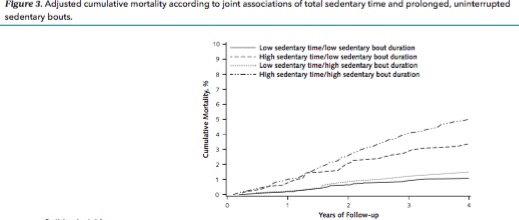
We’ve written about the importance of physical activity in maintaining health (for example here) at various times in the past. Most of the studies of activity have relied on people’s own reporting of what types of activity they typically perform, and conversely how much time they spend being inactive (TV watching, or computer working, for example). A new study just published in the Annals of Internal Medicine, however, takes much of the guesswork out of such research because the participants wore accelerometers. These devices tabulated activity counts over 1-minute periods, thus providing a fine-grained descriptor of the wearers’ activity or lack thereof.
Dr. Keith M. Diaz from the Columbia University Medical School and colleagues examined the activity and sedentary patterns of nearly 8,000 middle-aged and older white and black adult Americans. The data were derived from the accelerometers they wore continuously during their waking hours for seven days and for at least 10 hours per day.
This study was unusual in that it measured both the total amount of sedentary time and the length of each uninterrupted bout. And both factors were associated with all-cause mortality, the primary endpoint of the study. Participants were divided into 4 groups or quartiles, depending on the total amount of time (minutes per day) they spent being sedentary, with quartile 1 having the least amount of sedentary time, while quartile 4 had the most (636 vs 841 respectively), with quartiles 2 and 3 being intermediate between the two.
A number of characteristics differed between the quartiles. For example, the most sedentary people (Q4) had the greatest BMI, were more likely to have diabetes, high blood pressure, a history of heart disease and stoke. These factors increased in a significant trend from least to most sedentary. The investigators found that both the cumulative mortality also increased monotonically from Q1 to Q4 of total sedentary time. Further, the same trend was found with respect to the average length of bouts of sedentary time.
When the researchers assessed the joint associations of total sedentary timer and prolonged sedentary bouts, the participants fell into 4 groups:
- low sedentary time/low sedentary bout duration;
- high sedentary time/low sedentary bout duration
- low sedentary time/high sedentary bout duration
- high sedentary time/high sedentary bout duration
As might be expected, those in group 4 had a higher cumulative mortality than the other groups, as shown in the graph below.

Thus, these investigators have contributed data indicating that “prolonged, uninterrupted sedentary behavior is associated with a greater risk for all-cause mortality.” They also suggested:
Our finding of a joint association between the volume and pattern of sedentary behavior and mortality suggests that future guidelines should consider reductions in total sedentary time as well as prolonged sedentary bouts.
And they also said that:
... interrupting sedentary time every 30 minutes may protect against the health risks incurred by prolonged sedentariness. These data may be useful to inform specific recommendations for reducing sedentary behavior and support the concept that reducing and regularly breaking up sedentary time may be an important adjunct to existing physical activity guidelines.
While these data make a strong argument against a sedentary lifestyle, or even long bouts of being sedentary, there were some limitations to the study, the authors noted. For example, the participants only wore their accelerometers for 7 days — perhaps a longer period would have resulted in different data and conclusions. And these devices couldn't distinguish postural difference, e.g. sitting or standing. Would standing more have made a difference? Further, some of the participants' risk factors were collected at baseline and might have changed by the time they wore the accelerometers (about 6 years). So as with any study, replication of these results will be important.



